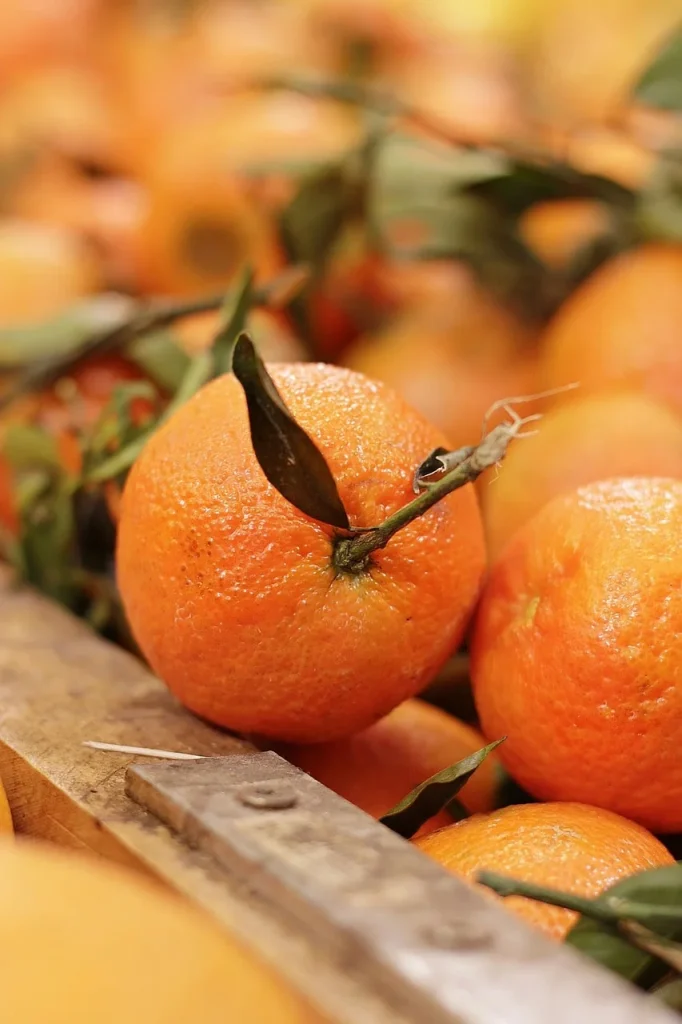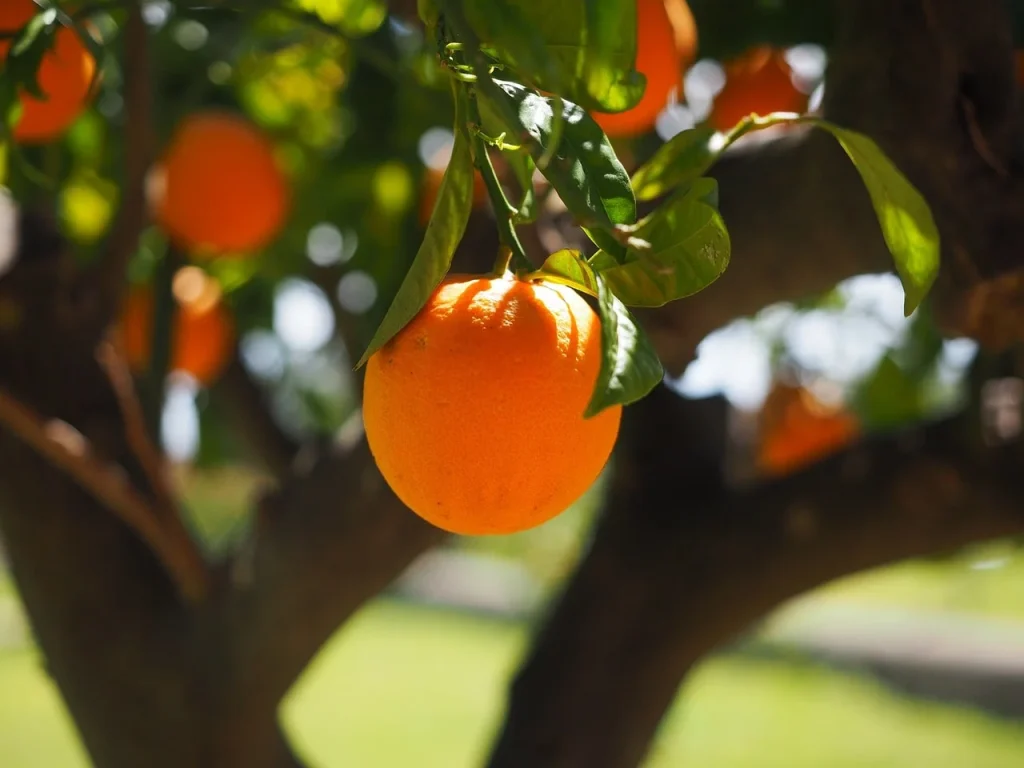Oranges: you’ve probably seen them, peeled them, and devoured their juicy segments, but how much do you really know about these vibrant fruits?
Today, we’re diving into some fun facts about oranges that might just make you see them in a whole new light. From their ancient origins to their role in modern cuisine, oranges are more than just a lunchbox staple.
They’ve been around the block, influencing cultures and tantalizing taste buds worldwide. And here’s a fun fact to kick things off: did you know that oranges are not even originally orange? More on that later.
An orange on the table, your dress on the rug, and you in my bed, sweet present of the present, cool of night, warmth of my life.
Jacques Prévert
Oranges Facts
Get ready to zest up your knowledge on oranges! Remember, there’s a quiz at the end of this article, so read each fact with care to show off your citrus expertise.
- This fruit can naturally lower cholesterol levels due to the presence of pectin, a soluble fiber that blocks cholesterol absorption.
- Christopher Columbus transported orange seeds to the Americas on his second voyage in 1493.
- The peel contains more fiber than the fruit itself.
- Orange trees are evergreens, seldom reaching beyond 30 feet in height.
- The flavonoids within this fruit can enhance blood flow and brain function.
- A substance called limonene, which makes up over 90% of the peel’s oil, provides its distinct scent.
- The fruit’s natural sugars are mostly sucrose, fructose, and glucose.
- The first recorded planting of an orange grove in America was in 1513 by a Spanish explorer.
- They are the largest citrus crop in the world, with around 70 million tons grown annually.
- Brazil is the leading producer, contributing about 30% of the world’s total.
- It takes about 50 glasses of water to grow enough oranges to produce a single glass of juice.
- The flowers of this tree are used in some perfumes and teas.
- They can produce fruit and flowers simultaneously during different seasons.

- Valencia oranges are often used in juice production because of their high juice content.
- Orange blossoms are the state flower of Florida.
- Unlike many fruits, they do not continue to ripen once picked.
- The color “orange” derives its name from the fruit, not the other way around.
- Spain has a festival where people throw these fruits at one another, known as La Tomatina.
- These trees can live for over 100 years.
- Orange zest, grated from the peel, is commonly used to add flavor to sweets and dishes.
- It has over 170 different phytochemicals and more than 60 flavonoids.
- Most commercially grown oranges are seedless varieties, especially navel oranges.
- The fruit’s white flower is known for its vibrant scent and is a popular choice in wedding bouquets.
- Orange leaves can be boiled to make tea.
- The largest orange ever recorded weighed approximately 1.4 kilograms (about 3 pounds).
- They are typically harvested between October and June.
- Orange juice is richer in vitamin C than whole fruit when consumed in the same quantities.
- Bitter oranges are often used in marmalades and liqueurs.

- Early forms were a hybrid of pomelo and mandarin.
- Larvae of the orange dog caterpillar feed on leaves and are camouflaged against the green foliage.
- In Chinese culture, presenting these fruits during the New Year is considered a gesture of good luck and prosperity.
- Vitamin C content in this fruit helps in the absorption of iron from plant-based foods.
- Oil extracted from the peel is used in furniture polish and as a natural pesticide.
- Orange juice was the first fresh food to be consumed on the moon.
- The skin can be used as a natural bird feeder in winter.
- Florida and California produce the most oranges in the United States.
- The fruit has more than 2000 natural compounds, most of which contribute to its aroma.
- During World War II, British pilots were rumored to eat large quantities of orange jam to improve their night vision.

- The pH level of their juice makes it a natural acid, which can clean surfaces and remove stains.
- Navel oranges get their name from the formation at the end of the fruit that resembles a human belly button.
- Ancient texts mention orange trees in the gardens of Southeast Asia from as early as 314 BC.
- Some varieties are specifically cultivated for their thick skin, making them easier to transport.
- The orange tree is the most commonly cultivated fruit tree in the world.
- Peel from this fruit is often used in composting as it decomposes rapidly and adds nitrogen to the compost.
- It takes about 50 oranges to create one liter of orange essential oil.
- Nutrients in the fruit can help prevent skin damage, reduce wrinkles, and improve overall skin texture.
- California’s orange production primarily serves the fresh fruit market, while Florida’s production mainly goes to juice.
- High doses of vitamin C found in orange juice can decrease the duration and severity of colds.
- The anti-inflammatory properties of oranges come from their high levels of hesperidin and magnesium.
- Some orange varieties change color from green to orange and back to green again as they ripen, depending on the temperature.
Oranges Myths

Now that we’ve explored the facts about oranges, let’s dive into some common myths. It’s important to distinguish what’s true from what’s simply a tale.
- Oranges Can’t Be Eaten at Night
It is commonly believed that they should be avoided at night due to their acidic nature and potential to disrupt sleep. However, there is no scientific evidence to support this claim. The natural sugars and vitamins found in oranges can actually contribute to a healthy bedtime snack. - Oranges Are the Richest Source of Vitamin C
Although they are widely recognized for their high vitamin C content, they are not the richest source. Other fruits and vegetables, such as guava, blackcurrants, and bell peppers, contain higher levels of vitamin C. - Drinking Orange Juice is Just as Nutritious as Eating an Orange
It is often assumed that drinking orange juice is nutritionally equivalent to eating a whole orange. However, the juice lacks the fiber found in the fruit’s pulp and skin, which is essential for maintaining healthy digestion and controlling blood sugar levels. - Oranges Should Always Be Bright Orange
The color of an orange is not always an indicator of its ripeness or taste. Oranges can sometimes be partially green or have blemishes, yet they can still be delicious and nutritious. The color variation is often caused by climatic conditions, not the fruit’s quality. - Eating Oranges Will Cure a Cold
While it is true that the vitamin C in them can support the immune system, there is no direct evidence that consuming oranges can cure a cold. However, being regularly included in the diet, oranges can help in maintaining overall health and enhancing immune function.
No products found.
Oranges Quotes

Let’s continue to the next section. Here you will find some of my favorite quotes about oranges. Feel free to share more in the comments so I can add them to the list as well.
Oranges are sunshine in a peel.
Unknown
This quote captures the bright, cheerful essence of oranges, likening their vibrant color and refreshing taste to rays of sunshine.
If an orange is sweet, it contains more of it.
Spanish Proverb
This Spanish proverb suggests that the sweetness of an orange can indicate its overall quality and abundance, emphasizing the virtues of goodness.
The orange never falls far from the tree.
Unknown
A twist on a well-known saying, this quote humorously applies the idea to oranges, underlining notions of origin and inheritance.
Oranges are not the only fruit, but they are the only fruit that can become more than they are when shared with someone else.
Jeanette Winterson
Jeanette Winterson, in her novel, which shares its name with this quote, metaphorically explores the idea of personal and shared experiences through the simple act of sharing an orange.
I like to peel it and share it with friends. You can spread sunshine in that very simple way.
Carmen Miranda
Carmen Miranda uses the act of peeling and sharing an orange as a metaphor for spreading joy and camaraderie among friends, a simple yet profound gesture.
Oranges FAQ

As we peel back from the vibrant quotes about oranges, we approach the final segment before your quiz. Pay close attention to these frequently asked questions to squeeze out every bit of knowledge!
- Which oranges are seedless?
Navel oranges are popular for being seedless and deliciously sweet. They’re perfect for snacking without the hassle of seeds. - Are oranges good for dogs?
Yes, they are safe for dogs in moderation. They provide vitamin C and potassium, but because of their sugar content, it’s best to give them in small amounts, especially to avoid upsetting your dog’s stomach. - Will oranges help you lose weight?
They can be a beneficial part of a weight loss diet as they are low in calories and high in fiber, which helps keep you feeling full. However, weight loss involves a balanced diet and regular exercise, so they’re just one piece of the puzzle. - Can oranges cause heartburn?
For some people, they can trigger heartburn due to their acidity. If you’re prone to acid reflux or heartburn, you might need to limit your intake of oranges and other citrus fruits. - Will oranges last longer in the refrigerator?
Yes, storing them in the refrigerator can extend their shelf life significantly. They can stay fresh for up to two to three weeks in the fridge, compared to about a week at room temperature.
No products found.
Oranges Trivia

Welcome to the Ultimate Orange Quiz! Better peel your wits and juice up your knowledge. If you don’t get any right, you might just turn into a lemon!
Oranges Merch
If you are a true fan of oranges, then you definitely need to check out our merchandise. You can find T-shirts, hoodies, mugs, and tote bags for your favorite designs. Feel free to check out all the other designs in our shop.
Conclusion
As we peel back the layers of the humble orange, it’s clear that this citrus champion is more than just a burst of sunshine on our taste buds. Oranges remind us of the simple joys that nature provides—nutrition, flavor, and vibrant color—all wrapped up in a biodegradable package.
Their versatility extends from the zest in our kitchens to the essence in our perfumes, proving that they hold a special place not just in our diets but in our lives.
Let’s continue to celebrate oranges, not just for their tangy taste but for the zest they add to our daily routines. Till next time, stay curious and explore more. Cheers.


